The distinctive features of artisanal design and industrial design.
##plugins.themes.bootstrap3.article.main##
Abstract
The theme of design is here addressed, understood in its broadest sense, therefore neither only aesthetic nor exclusively technical-productive. The intent is to privilege the point of view of the "design project" and to describe its connotations of implementation both in the craft and in the industrial activity. Then, there is the dichotomy between craftsman and artist, both linked to the anthropic factor of the place and its ‘genius loci’. In other words, there has always been that distinction between arts and crafts, where the latter, typical of craftsmanship, require manual practice like the former, but are aimed above all at the manufacture of objects with intrinsic functionality. The figure of the designer puts an end to this distinction. At last, an enunciation of the distinctive features of "industrial design" is provided.
##plugins.themes.bootstrap3.article.details##

This work is licensed under a Creative Commons Attribution-NonCommercial-ShareAlike 4.0 International License.
- Attribution — You must give appropriate credit , provide a link to the license, and indicate if changes were made . You may do so in any reasonable manner, but not in any way that suggests the licensor endorses you or your use.
- NonCommercial — You may not use the material for commercial purposes .
- No additional restrictions — You may not apply legal terms or technological measures that legally restrict others from doing anything the license permits.
- ShareAlike — If you remix, transform, or build upon the material, you must distribute your contribution under the same license as the original. NOTE: This point applies to numbers 1 to 20 of the magazine with the previous CC-BY-NC-SA 4.0 license. Does not apply to the new CC BY-NC 4.0 license from Volume 11, Number. 21 (2024).
References
Bayer, H. Gropius, I. and Gropius, W. (1938). Bauhaus 1919-1928. Museum of Modern Art, New York; First Edition (January 1, 1938). ASIN B000NS1QTI.
Camus, A. (1951). L'Homme révolté. Essais. Éditions Gallimard, Paris, France. Réimpression de 1985. ISBN 9782070323029.
Gregotti, V. (1986). Il disegno del prodotto industriale. Reprint 1998. ISBN 88-435-1209-9.
Grossi, F. (2003). Comunicazione ed Ergonomia, i nuovi strumenti di lavoro per l’imprenditore artigiano, dallo “sboom” della New Economy alla condivisione delle risorse. Confartigianato cultura, Pordenone, pages 74-104.
Munari, B. (1971). Artista e Designer. Giuseppe Laterza & Figli Spa, Roma-Bari. Reprint 2008. ISBN 978-88-420-6439-8.
Munari, B. (1977). Fantasia. Giuseppe Laterza & Figli Spa, Roma-Bari. Reprint 2005. ISBN 88-420-1197-5.
Norberg Schulz, C. (1979). Genius loci. Paesaggio ambiente architettura. Mondadori Electa, Milano. EAN 9788843542635.
Pansera, A. (1993). Storia del disegno industriale italiano. Giuseppe Laterza & Figli Spa, Roma-Bari. ISBN 88-420-4316-8.
Papanek, V. (2005). Design for the Real World: Human Ecology and Social Change, 2ª ed., Academy Chicago Publishers. ISBN 0-89733-153-2.
























